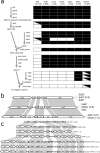Multiple concurrent and convergent stages of genome reduction in bacterial symbionts across a stink bug family
- PMID: 33833268
- PMCID: PMC8032781
- DOI: 10.1038/s41598-021-86574-8
Multiple concurrent and convergent stages of genome reduction in bacterial symbionts across a stink bug family
Abstract
Nutritional symbioses between bacteria and insects are prevalent and diverse, allowing insects to expand their feeding strategies and niches. A common consequence of long-term associations is a considerable reduction in symbiont genome size likely influenced by the radical shift in selective pressures as a result of the less variable environment within the host. While several of these cases can be found across distinct insect species, most examples provide a limited view of a single or few stages of the process of genome reduction. Stink bugs (Pentatomidae) contain inherited gamma-proteobacterial symbionts in a modified organ in their midgut and are an example of a long-term nutritional symbiosis, but multiple cases of new symbiont acquisition throughout the history of the family have been described. We sequenced the genomes of 11 symbionts of stink bugs with sizes that ranged from equal to those of their free-living relatives to less than 20%. Comparative genomics of these and previously sequenced symbionts revealed initial stages of genome reduction including an initial pseudogenization before genome reduction, followed by multiple stages of progressive degeneration of existing metabolic pathways likely to impact host interactions such as cell wall component biosynthesis. Amino acid biosynthesis pathways were retained in a similar manner as in other nutritional symbionts. Stink bug symbionts display convergent genome reduction events showing progressive changes from a free-living bacterium to a host-dependent symbiont. This system can therefore be used to study convergent genome evolution of symbiosis at a scale not previously available.
Conflict of interest statement
The authors declare no competing interests.
Figures




Similar articles
-
Cladogenesis and Genomic Streamlining in Extracellular Endosymbionts of Tropical Stink Bugs.Genome Biol Evol. 2018 Feb 1;10(2):680-693. doi: 10.1093/gbe/evy033. Genome Biol Evol. 2018. PMID: 29420776 Free PMC article.
-
Characterization of a novel Pantoea symbiont allows inference of a pattern of convergent genome reduction in bacteria associated with Pentatomidae.Environ Microbiol. 2021 Jan;23(1):36-50. doi: 10.1111/1462-2920.15169. Epub 2020 Aug 27. Environ Microbiol. 2021. PMID: 32686279
-
Differential genome evolution between companion symbionts in an insect-bacterial symbiosis.mBio. 2014 Sep 30;5(5):e01697-14. doi: 10.1128/mBio.01697-14. mBio. 2014. PMID: 25271287 Free PMC article.
-
Symbiotic factors in Burkholderia essential for establishing an association with the bean bug, Riptortus pedestris.Arch Insect Biochem Physiol. 2015 Jan;88(1):4-17. doi: 10.1002/arch.21218. Arch Insect Biochem Physiol. 2015. PMID: 25521625 Review.
-
Riptortus pedestris and Burkholderia symbiont: an ideal model system for insect-microbe symbiotic associations.Res Microbiol. 2017 Apr;168(3):175-187. doi: 10.1016/j.resmic.2016.11.005. Epub 2016 Dec 10. Res Microbiol. 2017. PMID: 27965151 Review.
Cited by
-
Host's demand for essential amino acids is compensated by an extracellular bacterial symbiont in a hemipteran insect model.Front Physiol. 2022 Sep 30;13:1028409. doi: 10.3389/fphys.2022.1028409. eCollection 2022. Front Physiol. 2022. PMID: 36246139 Free PMC article.
-
Single mutation makes Escherichia coli an insect mutualist.Nat Microbiol. 2022 Aug;7(8):1141-1150. doi: 10.1038/s41564-022-01179-9. Epub 2022 Aug 4. Nat Microbiol. 2022. PMID: 35927448 Free PMC article.
-
The secret life of plant-beneficial rhizosphere bacteria: insects as alternative hosts.Environ Microbiol. 2022 Aug;24(8):3273-3289. doi: 10.1111/1462-2920.15968. Epub 2022 Mar 26. Environ Microbiol. 2022. PMID: 35315557 Free PMC article. Review.
-
The importance of host physical niches for the stability of gut microbiome composition.Philos Trans R Soc Lond B Biol Sci. 2024 May 6;379(1901):20230066. doi: 10.1098/rstb.2023.0066. Epub 2024 Mar 18. Philos Trans R Soc Lond B Biol Sci. 2024. PMID: 38497267 Free PMC article. Review.
-
Pantoea bathycoeliae sp. nov and Sodalis sp. are core gut microbiome symbionts of the two-spotted stink bug.Front Microbiol. 2023 Nov 30;14:1284397. doi: 10.3389/fmicb.2023.1284397. eCollection 2023. Front Microbiol. 2023. PMID: 38098653 Free PMC article.
References
-
- Giron D, et al. Influence of microbial symbionts on plant-insect interactions. Adv. Bot. Res. 2017;81:225–257. doi: 10.1016/bs.abr.2016.09.007. - DOI
MeSH terms
Substances
LinkOut - more resources
Full Text Sources
Other Literature Sources

